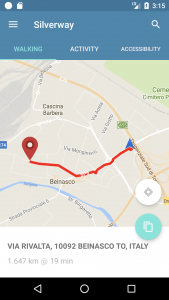The increasing spread of ubiquitous computing is contributing in the improvement of the people’s quality of life thanks to the large amount of data made available by the customary use of technological devices as support tools for everyday tasks.
As the full integration of the citizens in the urban fabric represents one of the challenges of tomorrow, innovative solutions are needed in order to radically change how the people experience the city in terms of accessibility, social inclusion, security and community well-being. In particular an improved mobility framework can help the most vulnerable and needy strata of the society such as elders and impaired people that are often excluded or poorly integrated in the workflow of the urban “jungle”.
Several solutions have been released by the major technological players to address these specific needs. Waze is one of the most interesting project: this innovative navigation app integrates a community based approach that exploits the collective knowledge derived from the users’ contributions to strengthen the driving experience of each single user.
Google have also recently made a step forward in the improvement of the navigation framework adding a new functionality to its Google Maps service in order to take in account the needs of people who use wheelchairs or with other mobility needs. This new functionality gives the possibility to select a new “wheelchair accessible” profile that takes mobility needs into consideration. This feature has been rolled out starting with London, New York, Tokyo, Mexico City, Boston and Sidney.
However, architectural barriers are not the only obstacle that can be encountered along the way and shorter routes are not always the best if we consider other factors in addition to the time taken. For example one of the main problems for an elderly person could be the path of totally sunny roads and therefore particularly muggy in summer or frozen roads or covered with leaves (and therefore slippery) in winter. SilverWay is the new pedestrian navigation app developed by Ab.Acus that thanks to the different walking profiles available will tailor the most suitable route according to the specific user needs taking in account all the path parameters responsible for the quality and safety of the walking path.
SilverWay also overcomes the limits of existing navigation apps that are often not well aligned to the local settings integrating the typical Big Data approach based on different and real-time data sources:
- Road surface conditions, street’s slope, architectural barriers and the presence of trees (index of shaded streets) and pollen along the city’s streets provided by Public Administration Technical Databases.
- Maps with route planning provided by OpenStreetMap.
- Real time data obtained from the user community about news related to unexpected events on their way as accident, demonstration, events that make circulation difficult due to overcrowding; work in progress as scaffolding that make some sidewalks not passable; ice or leaves along the path that make it dangerous to walk. This can be done by the user creating a note directly on the map and reporting the problem found by choosing from a list of options. The addition of notes also responds to the elder’s desire to make himself useful for the community.
SilverWay works also as a wellness and wellbeing monitoring tool thanks to the embedded motion tracking features that exploits the user smartphone sensors to track the activity along the provided path. This information acts both as a stimulus for the user in performing aerobic training and as a transparent monitoring tool that can provide lifestyle data to local area doctors and healthcare providers about their beneficiaries. Thus Silverway can also be used as a tool to support Adapted Physical Activity program for elders and impaired people.
In May Ab.Acus will start the beta testing phase of Silverway in collaboration with the Municipality of Beinasco. A first group of citizens will be involved and the system will be validated for the first time in real operating conditions. Thanks to this first trail the solution will be tuned according to the feedbacks collected directly from users and stakeholders contributing to the definition of the final market-ready release.
Simone Tonti
Product Development Manager at Ab.Acus


